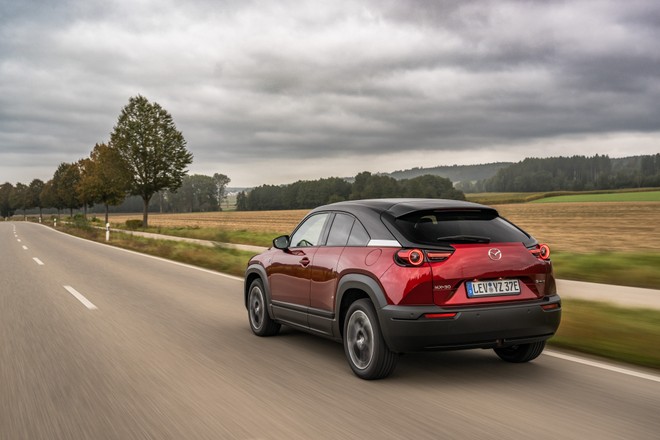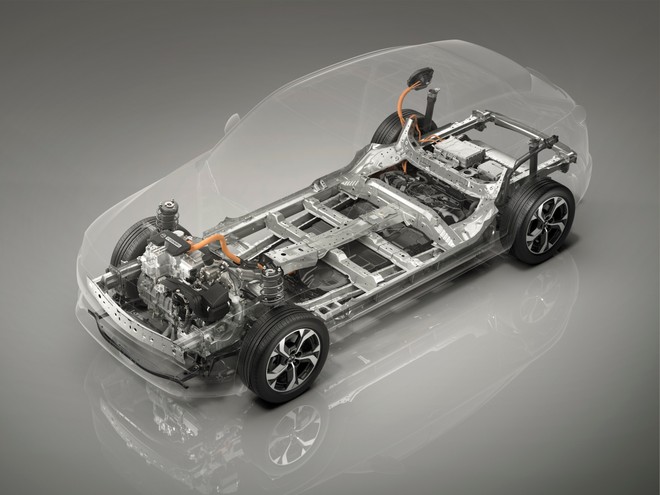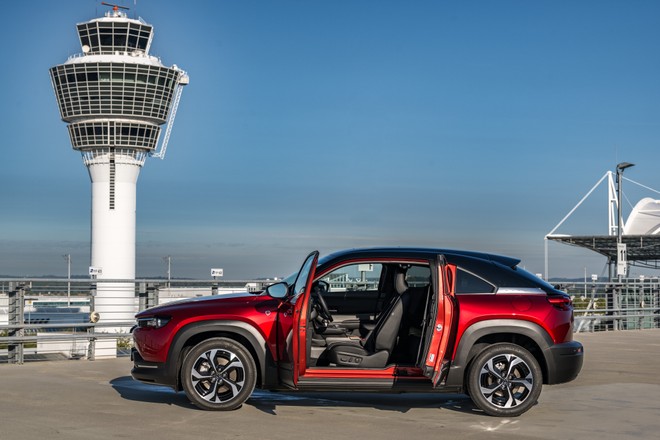Mazda MX-30 R-EV is the protagonist of the first road test for this updated, or rather “completed” model. In fact, since the launch of the electric version, the bonnet showed a conspicuous compartment made to house a power unit. thermal, in this case a Wankel rotary motor which pairs well with the electric one, which is also similar in philosophy (stator-rotor).
Clearly this is a different Wankel from those seen in the past: its previous declinations have also reached versions aimed at performance on the track (it won at Le Mans in 1991) and on the road, with the RX-7 twin rotor and supercharged.
Today, and two million Wankels after the first debut on the Cosmo Sport in 1967, on the MX-30 e-Skyactiv R-EVthe rotary sports a displacement of 830 cc and delivers 75 hpdrawing on 50 liters of tank.
HOW IT WORKS 
< p>Mazda MX-30 R-EV can be considered an electric with range extender or a plug-in (series) hybrid,depending on your point of view. Technically it is a plug-in hybrid car that can be reload and whose traction is always electric, in fact it is a hybrid in series and not in parallel. It means that the heat engine is not working properly. physically connected to the wheels and does not generate traction: it always works as an electricity generator.
Using the fifty liters of petrol in the tank, and working at maximum (its) efficiency because free of friction in the kinematic chain and the result of optimization work on its components, the Wankel generates electricity which can send via two parallel lines, like this to store it in the battery or supply it directly to the engine.
This is important to ensure that the MX-30 can always have the same performance even with a flat battery, where a lower starting current of the battery is aided by the electricity directly generated by the petrol. Furthermore, the little Wankel of the MX-30 should also drink less oil than its ancestors, so Mazda promises: services every 20,000 km.
When used as a plug-in hybrid, the MX-30 R-EV charges in alternating current at 11 kW or in direct current, via CCS, at 36 kW (25 minutes to go from 20 to 20 kW). 80%).
The modes There are three driving modes, to be evaluated depending on the case and all limited to a speed of 140 km/h. maximum: on the other hand, the MX-30 R-EV can do yes many kilometres, but it still remains a compact car and therefore with a more sophisticated philosophy. town and highway.
In mode Normalshe uses the battery energy until it reaches 45% of the State of Charge (SoC). Having reached that point, the car activates a series of energy generation cycles: imagine a wave graph, turning the thermal switch on and off to maintain 45% of the charge and reduce petrol consumption to a minimum.
Curiosity: the MX-30 R-EV has V2L, the possibility to use the 230 V socket (1.5 kW output power) to charge any device.
By activating the mode EV, on the other hand, communicates to the car that we want to travel as much as possible. possible with zero local emissions. The car consumes the entire battery and only at the end of its capacity. will go to activate the combustion engine with generation and discharge cycles like a traditional hybrid.
Finally there is the mode Recharge: by activating it we can choose the percentage of battery to conserve, a number between 20 and 100% in increments of 10 percentage points, and it will activate the generator to (possibly) reach it and then maintain it.
HOW IS IT GOING? ROAD TEST 

Compared to the electric version, the R-EV does not radically change its driving dynamics because traction is always electric, here we have some of extra thrust thanks to the 170 hp (125 kW) of the latest generation synchronous electric (water-cooled), but the performance is more or less the same as the previous tests.
The 0-100 of 9.1 seconds in the technical data sheet is realistic, and shooting on the highway is aided by a good torque for the type of car, 260 Nm.
The only problem is that the speed maximum of 140 km/h (from the speedometer 145 km/h during the test) risks limiting us in those situations in which a small boost up to the real 150 km/h could be useful for a more rapid overtaking. quiet, but all this it must be put into context with the fact that we were in Germany in a stretch without limits…

 Mazda MX-30: review, consumption and charging tests (AC, DC and IONITY) 92
Mazda MX-30: review, consumption and charging tests (AC, DC and IONITY) 92
Cars 04 Jan

 Mazda MX-30: proof of real consumption, how much does charging cost and cost per 100 km 113
Mazda MX-30: proof of real consumption, how much does charging cost and cost per 100 km 113
Cars 18 May
The same goes for electric efficiency: here we have a battery halved compared to the EV (17.8 kWh), but it is still a fairly light car that proves to be very efficient in the city. and in the extra-urban. The test at the BrianzaRing confirmed this (13.8 kWh/100 km) and the first test of the Plug-In used in mode electric only returned 16 kWh/100 km on a mixed route with a part of the highway.
80 real electric kilometers are absolutely within reach in mixed conditions, almost 100 in the city. An exception is the situation in which winter and you only use it on the motorway, but at that point it makes no sense to do it in winter mode. EV and it is better to activate operation as a series plug-in hybrid using the generator.
The plug-in hybrid has a prismatic cell battery that is half the size of the electric one, but weighs more. due to the combustion engine and the tank. The battery weighs 188.2 kg (half that of the EV), but the car weighs 1,778 kg, almost 60 kilos more of electricity.
Moving on to petrol consumption, a clarification must be made: the MX-30 R-EV is a car that can be very efficient but it must be understood and used in the right way. Here are two scenarios:
- do you cover less than 100 kilometers in the city or 80 kilometers in the mixed? Use it electrically, charge it every evening and you won't consume even a drop of petrol
- Does your daily route exceed electric range or include a lot of motorway? The advice is use it in Normal starting from the charged battery. Depending on the distance travelled, you will be able to record average consumption between 3 and 6 liters per 100 kilometres, depending on your route and the type of roads to be tackled.
What happens when does the battery run out?I also did that test: the car almost constantly activates the generation cycles via the Wankel and, in these conditions, the consumption recorded is of approximately 6.5 liters every 100 kilometers with the battery at zero and the request to bring it back to 45%. If, however, you travel with zero battery but choose to recharge only through regeneration during braking, then you can even go down to 6 liters/100 km because the rotary must work less constantly.
DATASHEET 

TECHNICAL SHEET MAZDA MX-30 e-SKYACTIV R-EV
- Engine: single permanent magnet synchronous electric motor, front-wheel drive
- Power: 125 kW/170 hp, 260 Nm
- 0-100 km /h: 9.1 s
- Speed maximum: 140 km/h
- Battery: 17.8 kWh, weight 188.2 kg
- Front suspension strong>: MacPherson
- Rear suspension: torsion bar
- Tyres: 215/55 R18
- Brakes: discs ventilated
- Empty weight: 1,778 kg
- Min/max trunk space: 350 litres
- < strong>Length: 4,395 mm
- Width: 2,035 mm (with mirrors)
- Height: 1,555 mm
- Wheelbase: 2,655 mm
PRICES 

How do you want your Mazda MX -30? Purely electric or hybridwith half the battery? Make your choice based on use, because the price factor is not differentiating factor: both cost 38,520€ in the starting version, 39,470€ in the Exclusive Line setup and 41,770€ for Makoto.
At 1,400€ you can purchase Driver Assistance & Sound Pack with Bose system, 360° camera, driver monitoring, rear emergency braking with pedestrian detection, rear emergency braking when exiting parking and cruise & traffic support (CTS).
The most popular version expensive, only for the R-EV, it is the Edition R for 46,020€.
VIDEO
Limited budget? Redmi Note 12 4G, buy it at the best price from Amazon at 142 euros.